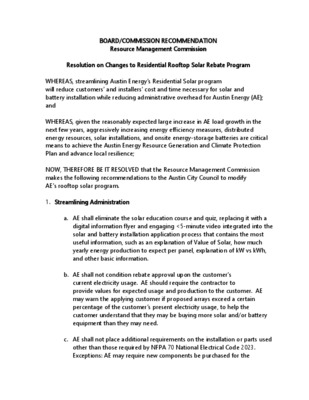Item 5- Draft Recommendation on Changes to Residential Rooftop Solar Rebate Program — original pdf
Backup

BOARD/COMMISSION RECOMMENDATION Resource Management Commission Resolution on Changes to Residential Rooftop Solar Rebate Program WHEREAS, streamlining Austin Energy’s Residential Solar program will reduce customers’ and installers’ cost and time necessary for solar and battery installation while reducing administrative overhead for Austin Energy (AE); and WHEREAS, given the reasonably expected large increase in AE load growth in the next few years, aggressively increasing energy efficiency measures, distributed energy resources, solar installations, and onsite energy-storage batteries are critical means to achieve the Austin Energy Resource Generation and Climate Protection Plan and advance local resilience; NOW, THEREFORE BE IT RESOLVED that the Resource Management Commission makes the following recommendations to the Austin City Council to modify AE’s rooftop solar program. 1. Streamlining Administration a. AE shall eliminate the solar education course and quiz, replacing it with a digital information flyer and engaging <5-minute video integrated into the solar and battery installation application process that contains the most useful information, such as an explanation of Value of Solar, how much yearly energy production to expect per panel, explanation of kW vs kWh, and other basic information. b. AE shall not condition rebate approval upon the customer’s current electricity usage. AE should require the contractor to provide values for expected usage and production to the customer. AE may warn the applying customer if proposed arrays exceed a certain percentage of the customer’s present electricity usage, to help the customer understand that they may be buying more solar and/or battery equipment than they may need. c. AE shall not place additional requirements on the installation or parts used other than those required by NFPA 70 National Electrical Code 2023. Exceptions: AE may require new components be purchased for the installation, and this requirement does not extend to the software configuration of said parts, I.e. export limits or grid operator control settings. 2. Consumer Protection a. AE shall specify a minimum set of 10-year warranty provisions (they must identify exactly what is included in the warranty) that every installer must offer to be eligible for the rebate list. Installers can offer other provisions beyond that minimum set. This is a consumer protection requirement which intends to eliminate the possibility of a security-blanket warranty, which may have loop-holes in the warranty. b. AE shall provide up-to-date interactive reference solar benchmark cost estimates for a few house types and roof scenarios to give customers a valid point of comparison to evaluate solar contractors’ sales cost quotes. This should include, but not be limited to: Asphalt/comp shingle roof, metal roof for one and two story homes. These shall be based on real quotes that represent mean pricing. This is a consumer protection requirement that aims to supplement the already provided $/W figure by making cost hiding more difficult for installers. c. AE shall require 75% TSRF (Total Solar Roof Fraction) for 3 kW of the total proposed solar installation, but not for the entire array. AE shall require the contractor to calculate the TSRF for the entire array and communicate that estimate to the customer with an explanation of what that means for estimated annual array energy production. 3. Standard for New Inverters a. For interconnection agreement, AE shall require all distributed energy inverters to meet the IEEE 1547-2018, Category II standard, with frequency-watt mode, also known as frequency-droop response, enabled. A different grid protection mode may be required by AE provided AE provides study and rationale to City Council. 4. Improvements in AE Solar Inspections a. Physical on-site inspections shall be done asynchronously between the inspector and contractor (neither party is required to meet at an appointed date and time). b. Solar inspections shall be conducted using an online submission process, with the installer or contractor uploading a set of labeled photographs of the installed equipment to an AE online inspection portal. These photographs must be verifiable as to date and location and address every item that AE specifies as necessary to evaluate the safety and effectiveness of the solar installation. c. Online inspection submittals shall include proof that the contractor has conducted an online commissioning test proving successful operation of PV system. d. AE’s installation approval or failure notes shall be returned to the contractor within one business day. e. If any contractor’s initial online inspection failure rate equals or exceeds 20%, then AE may require those poorly performing contractors' installations to be subject to in-person physical inspection. AE should provide a work quality pathway for poor performing contractors to earn their way back to the online inspection process. f. AE may conduct random physical, on-site inspections to validate the effectiveness and accuracy of the online inspection submittals and the process itself. The sample shall be statistically significant, but may not exceed 10% of all online inspections. g. Inspections shall contain no additional requirements beyond “shall meet NFPA 70 National Electrical Code 2023." h. Other than verifying model numbers installed, inspections shall require no additional checks for items that are already covered by manufacturer and vendor Distributed Energy Resource standards, including UL 1741, UL 1973, UL 9540, and IEEE 1547-2018. 5. Implementation Schedule a. Implementation deadline for these recommendations shall start no more than 15 months from the date they are approved by the Austin City Council.